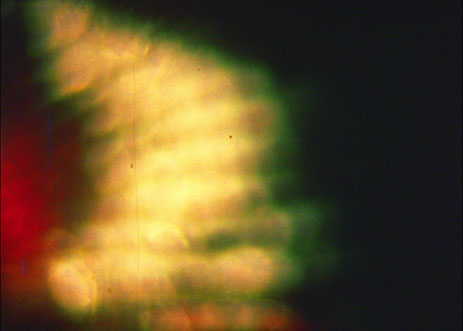Steve Polta in person
An unmade neighborhood. A ghost town in reverse. A vague orange glow and a dawning. A chirp of a bird and a chirp and a chirp. One more chirp and he wakes. It is not sleep he emerges from but more a thoughtless dull reverie achieved when finally tumbling thought and heart-racing panic spiral down and admit defeat to this raging body, dissipating into a hum of empty nerves, as sentient as a street lamp on an eternal street in town. A stinging eye cracks open. Crusty blur and fog. A chill accompanies the crack at dawn and this eye is quickly closed, a retreat from the glaring day into the somnolent pink within. From whence we came, through this night and into this life. The void resolves to a pink/grey flatness, a flatness closer than his eyes, closer than his brain. Fearing this inversion, he knows he is done for. Sleep will not come now and of course never would have come. Memories those looping memories return as blood pumps sluggishly.
Red Sketch (1997c)
1997, super 8, 6 min.
Interval Oakland 99
2000, super 8, 3 min.
Departure (1997c)
1997, super 8, 7 min.
Picture Window (1996a)
1996, super 8, 8 min.
Minnesota Landscape
1997, 16mm, 12 min.
Estuary #1
1998, super 8, 10 min.
The Berries
2000, super 8, 4 min.
Summer Rain for LMC, side A
2007/2011, super 8, 3 min.
Summer Rain for LMC, side B
2007/2011, super 8, 3 min.
A House Full of Dust
2007, super 8, 10 min.
Besides being the artistic director of the San Francisco Cinematheque (and having been a taxi driver in that same city), Steve Polta has his own filmography, that he has constructed between the middle of the 90s and principles of this decade. Almost secret films, which many people have heard of (wonders) and few have actually been able to see: hence this occasion, the first time they are projected in this continent, is almost like a solar eclipse or the passage of a comet. Just to create interest before this light event, it must be said that these are mostly super 8 films, in which sometimes light seems to slip on tiptoe through the lens of the camera and through the emulsion, while other times seems to burst into by surprise. From abstraction to minimal figuration, they seem to reflect on everything that is only possible to see through the “eyes” of a camera, and on what only a film strip can do with photosensitive material. A set of movies that turn the ordinary into extraordinary, light phenomena from across the ocean that caress our screen.
In collaboration with AC/E Acción Cultural Española

